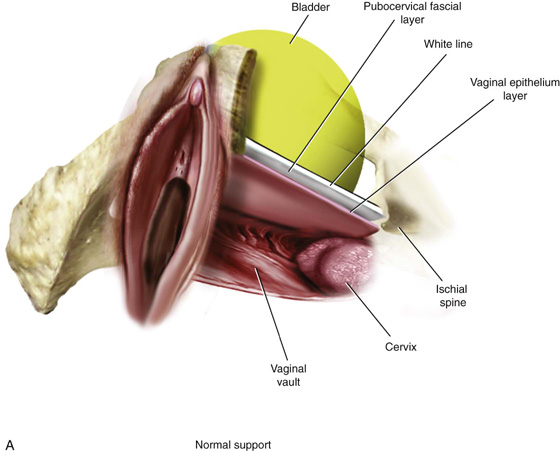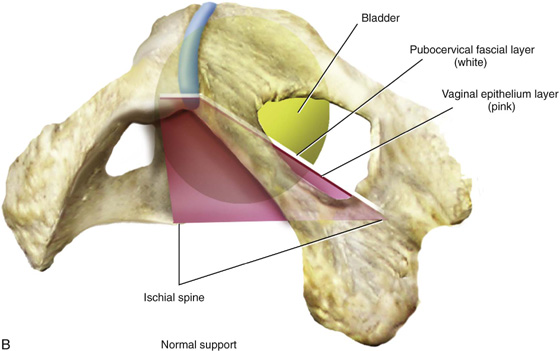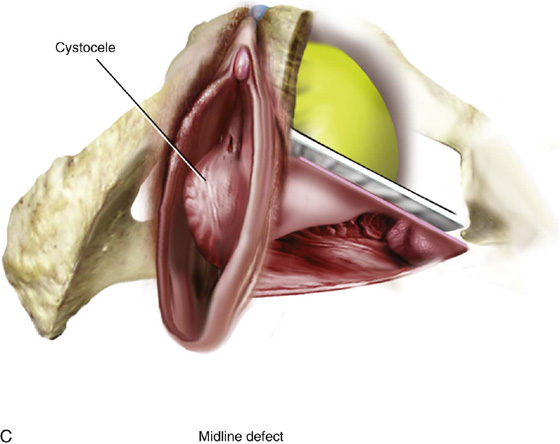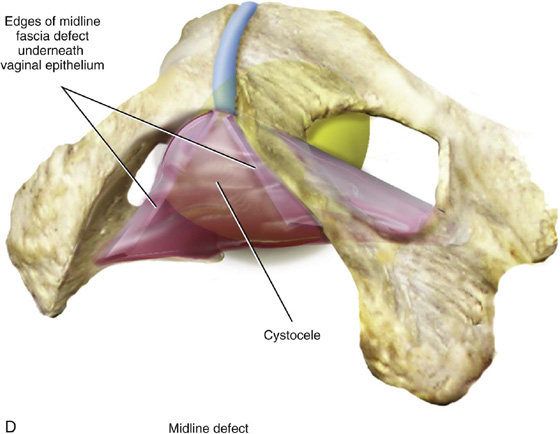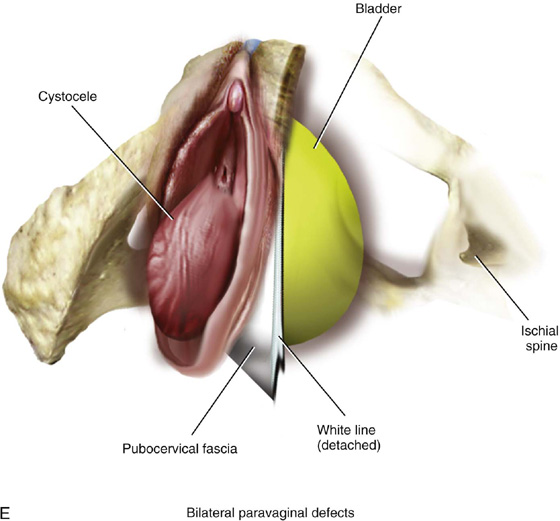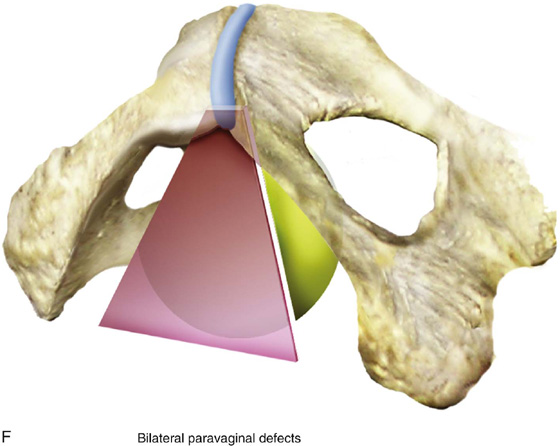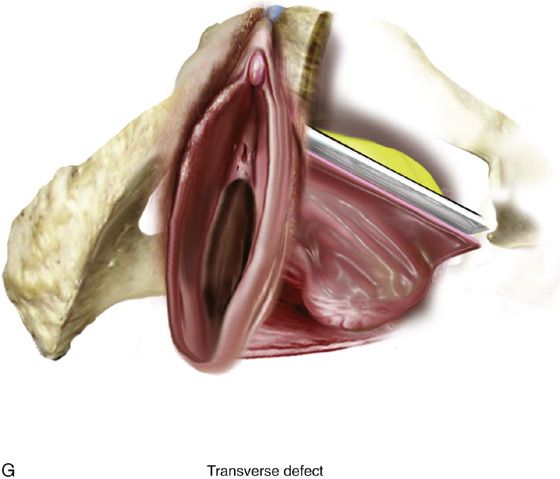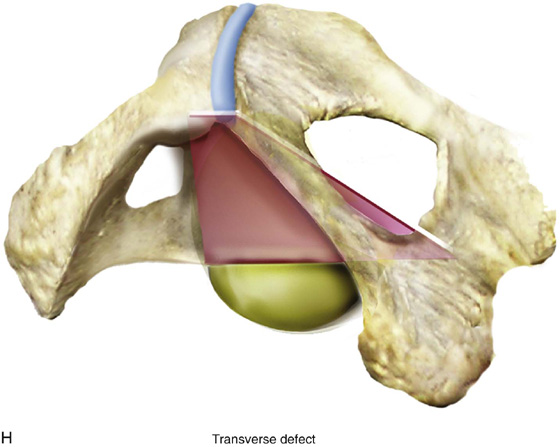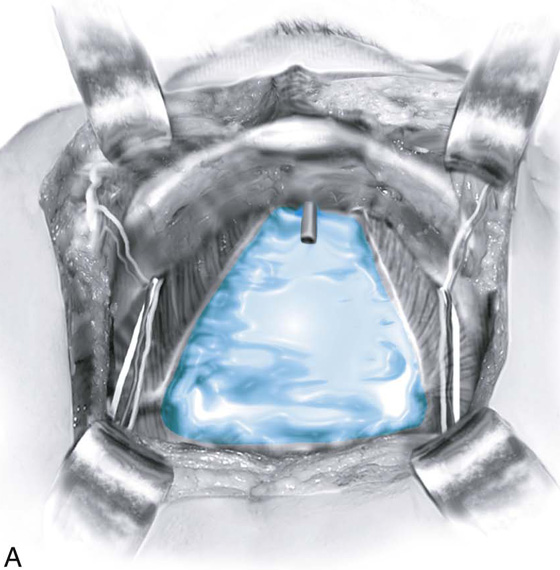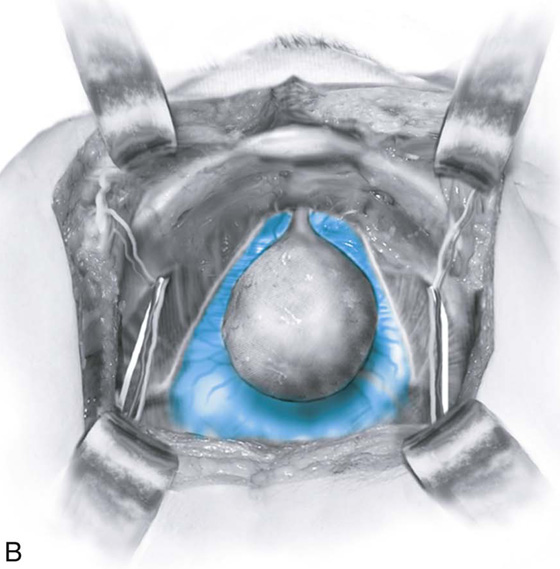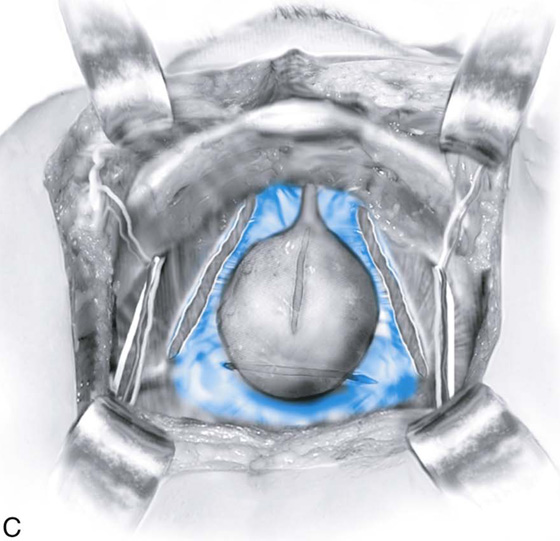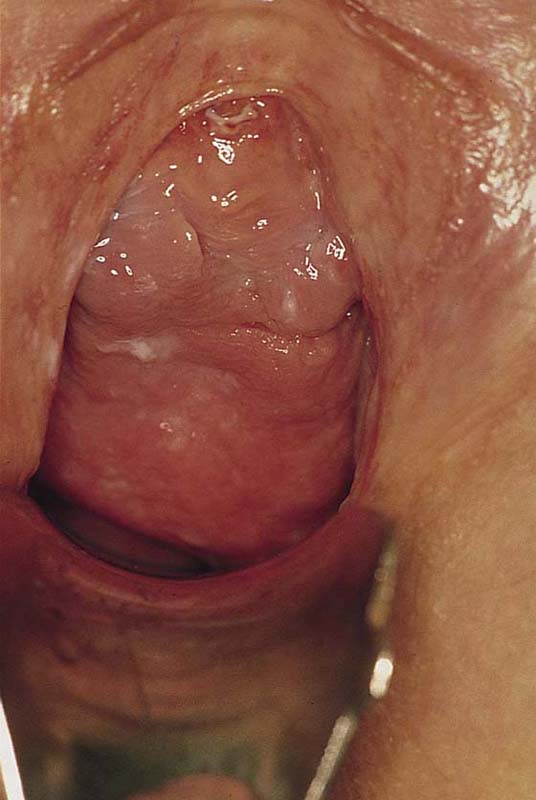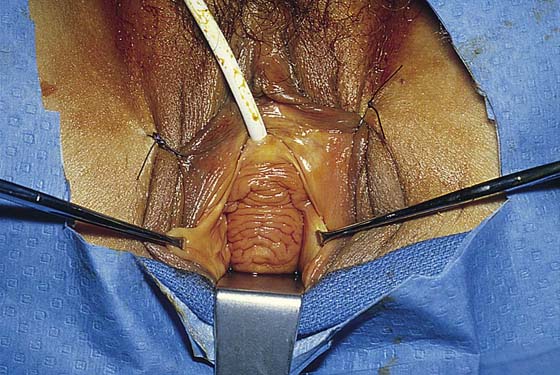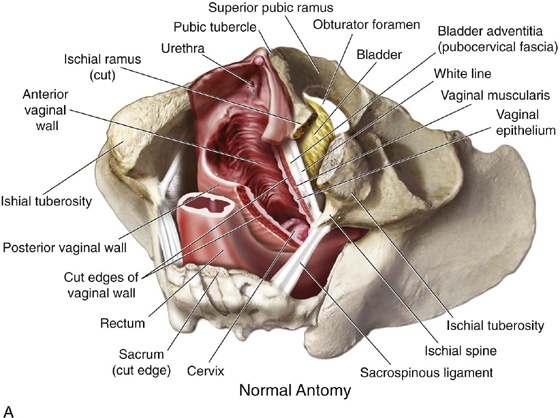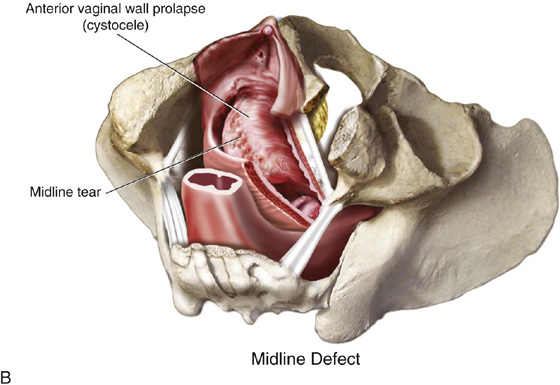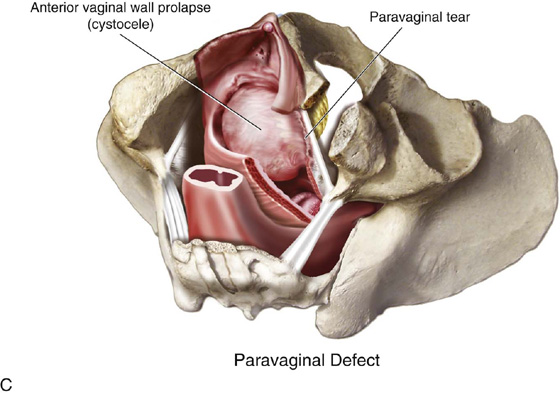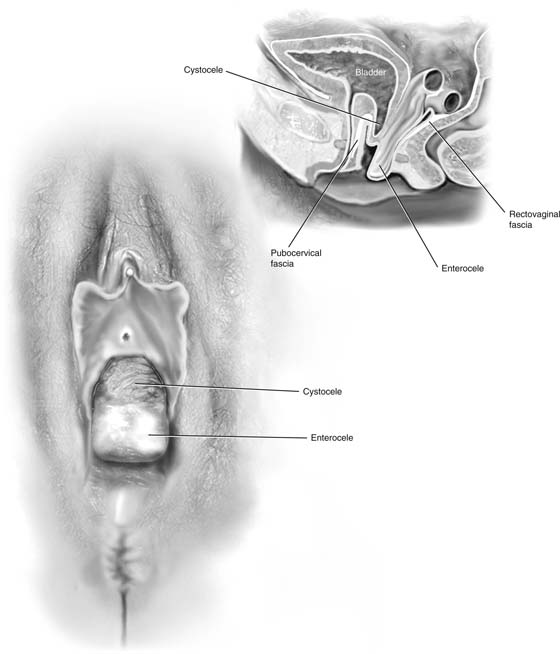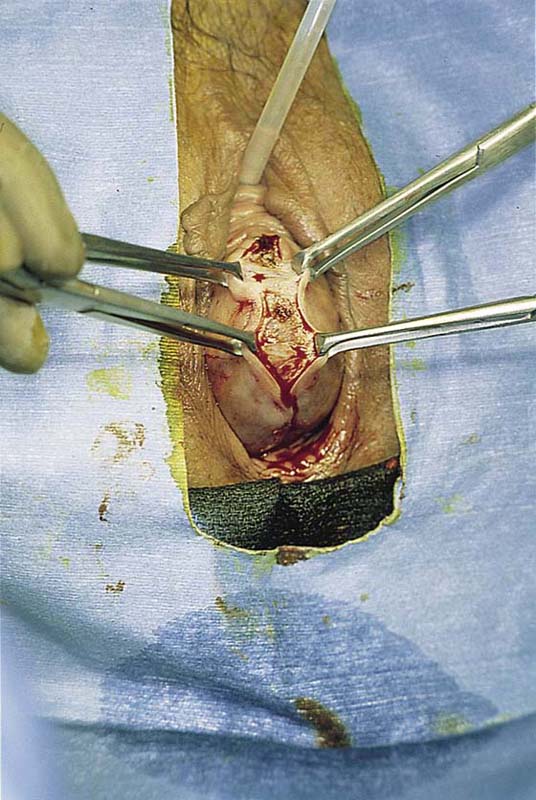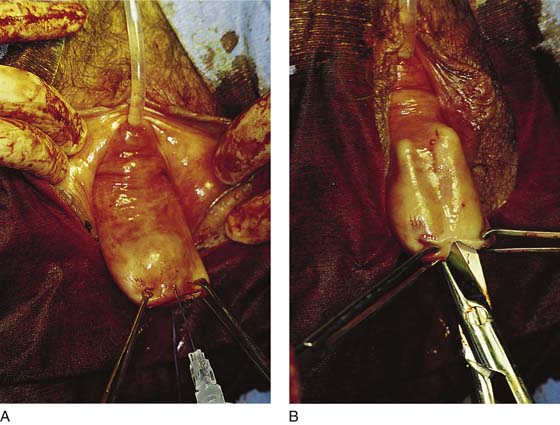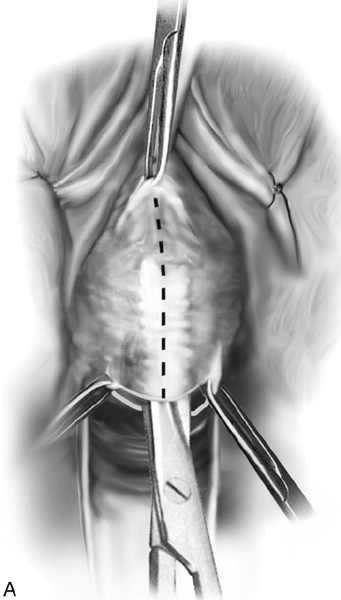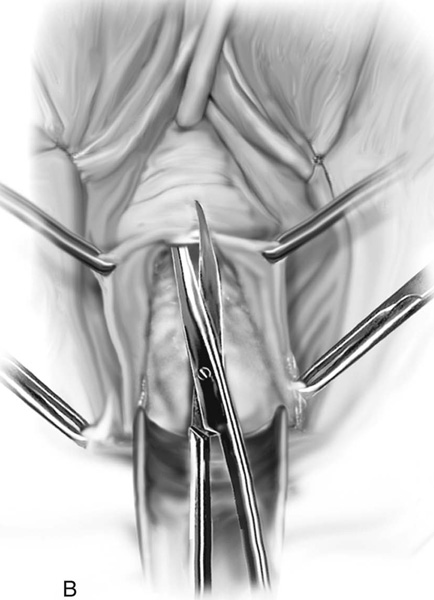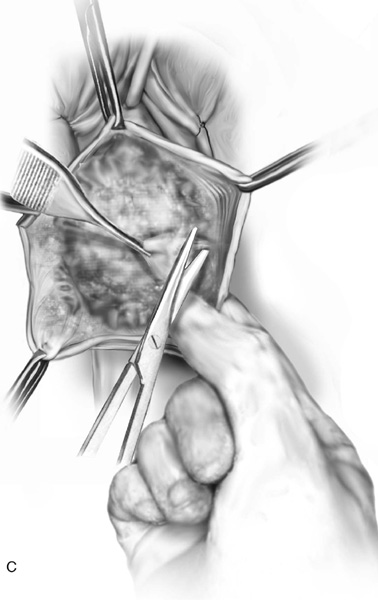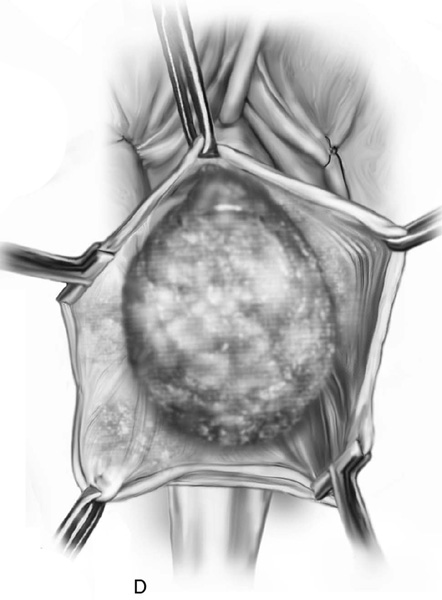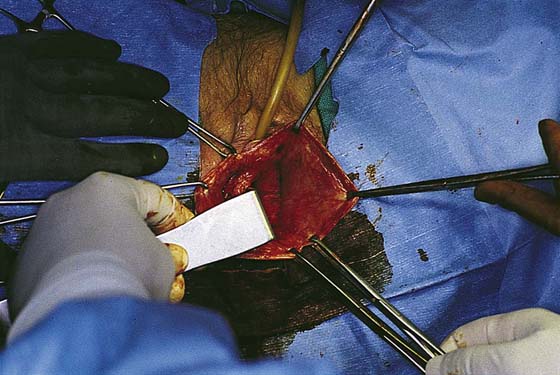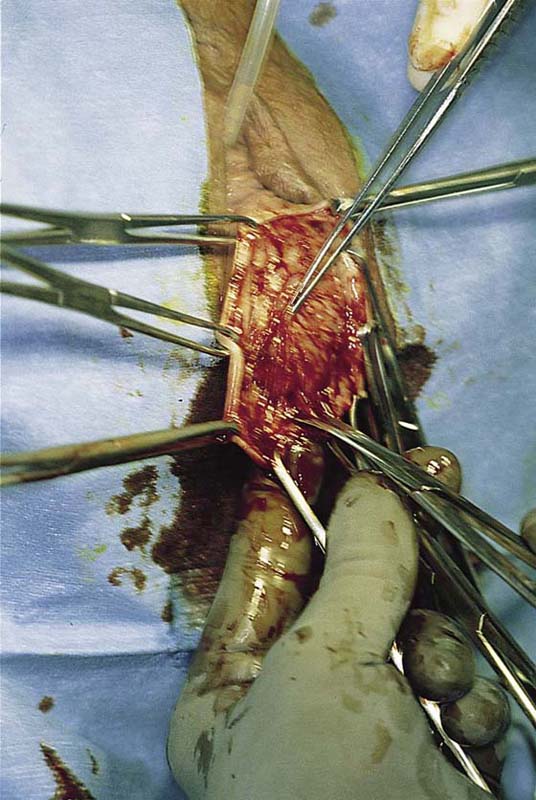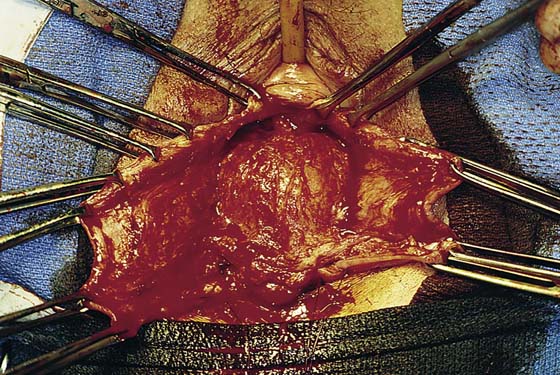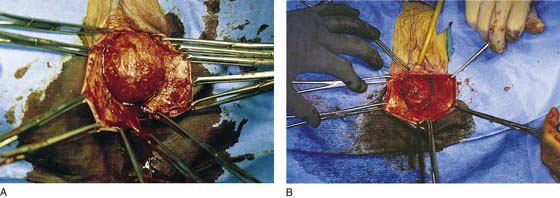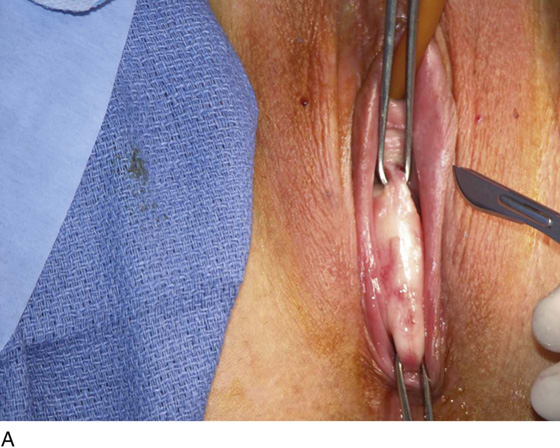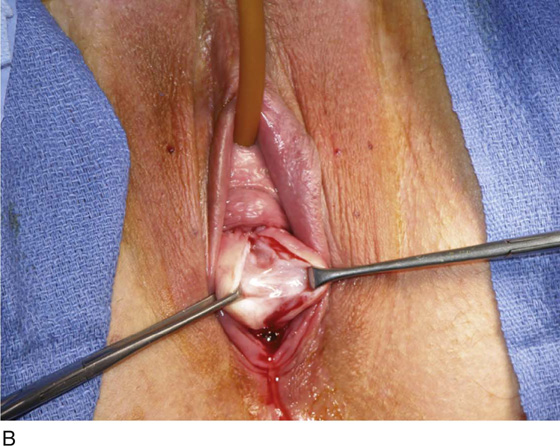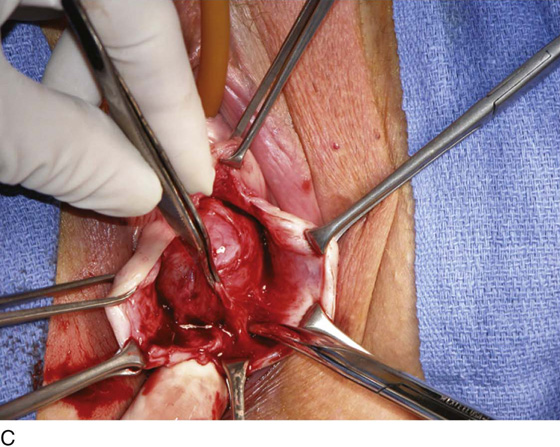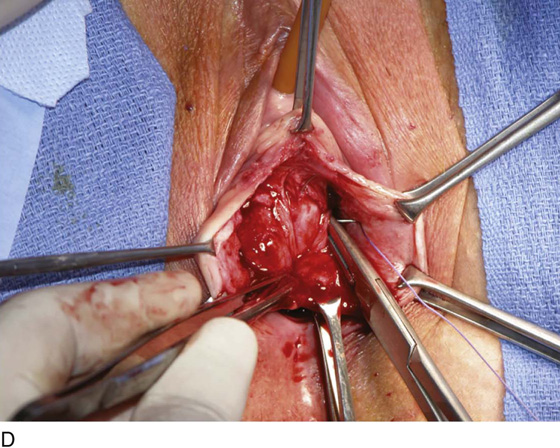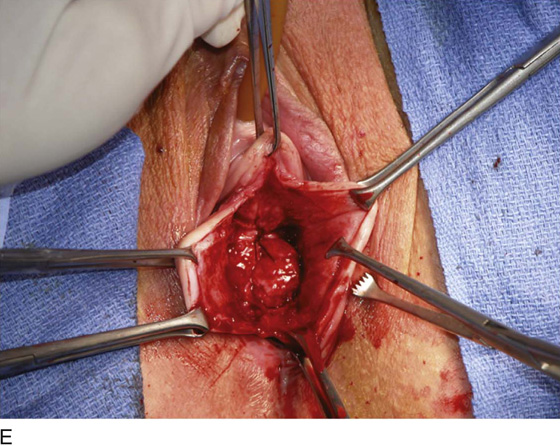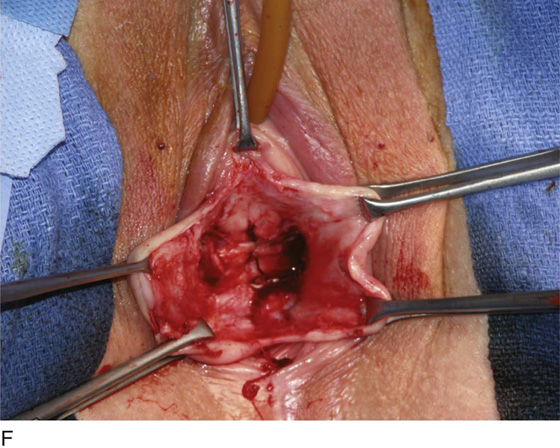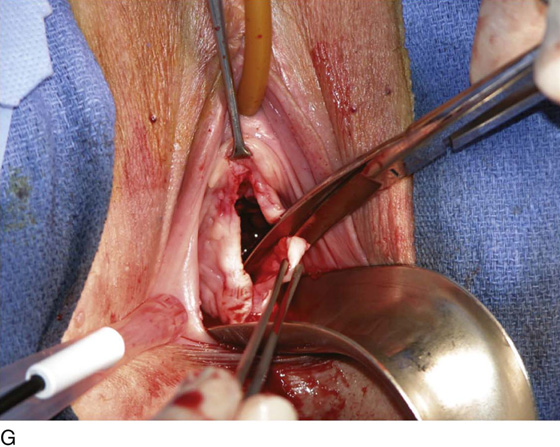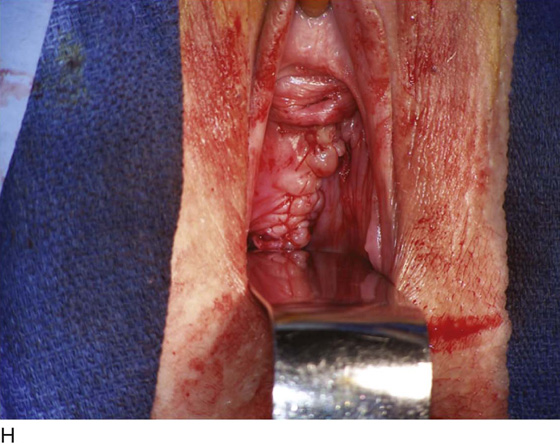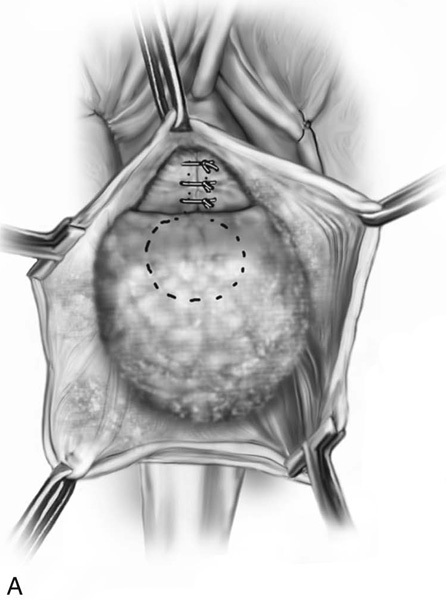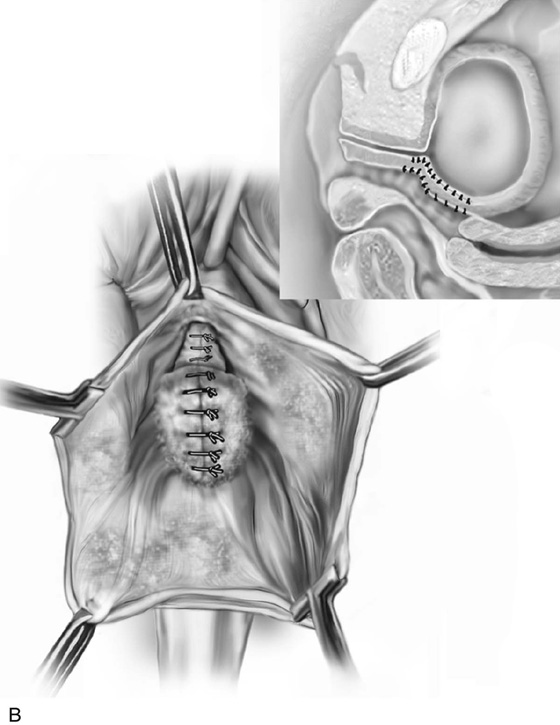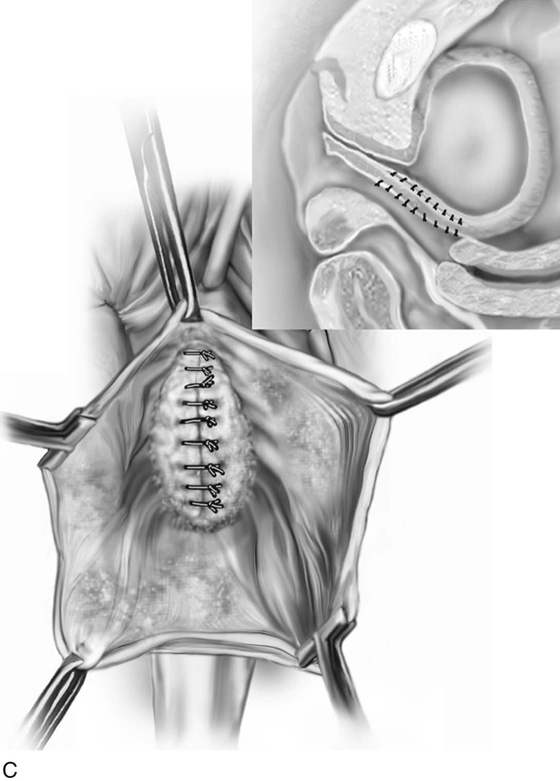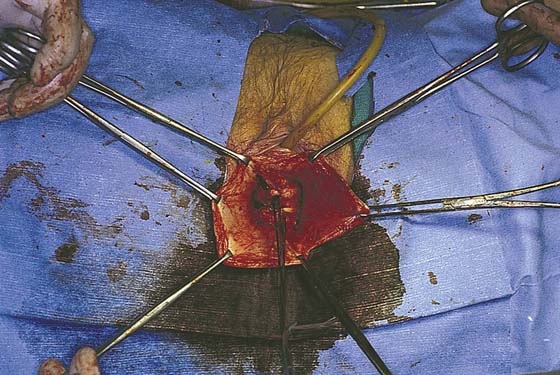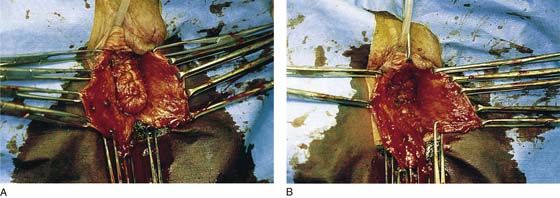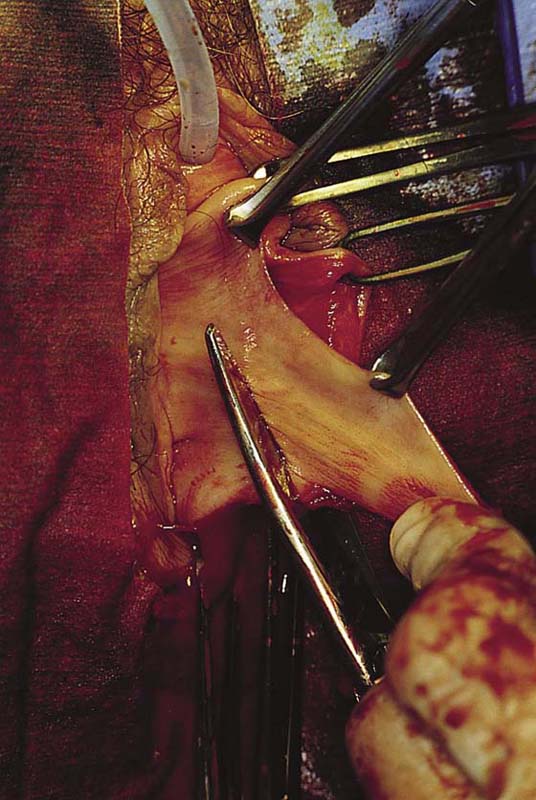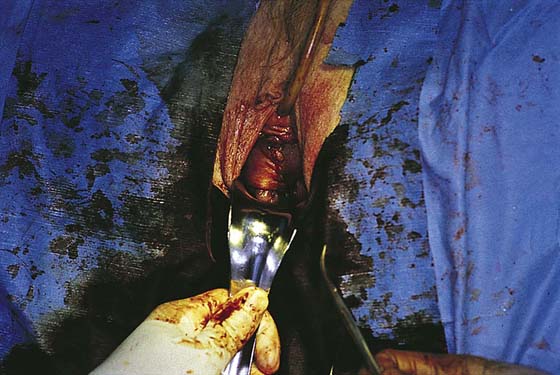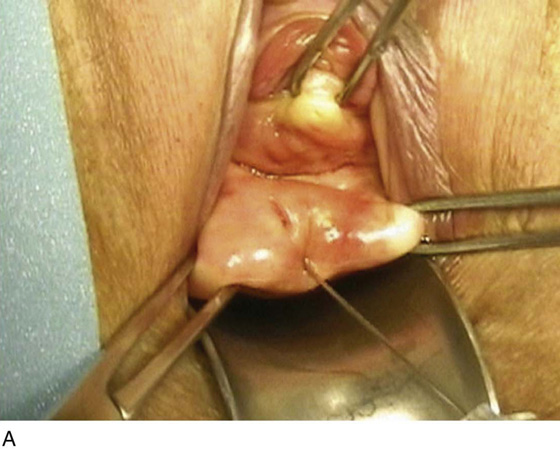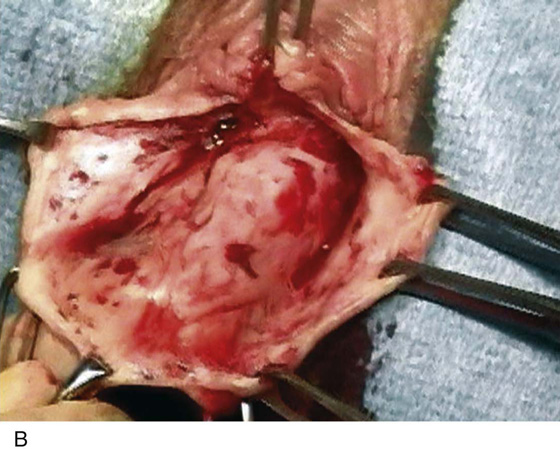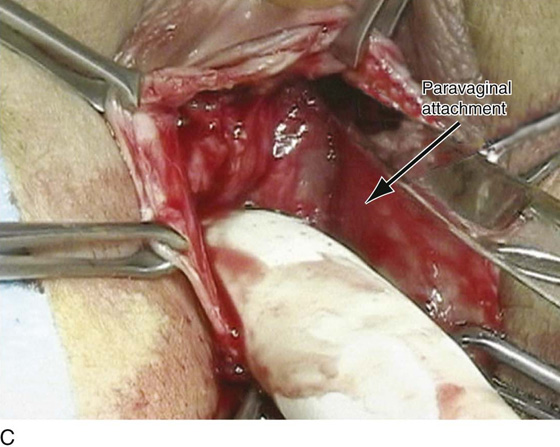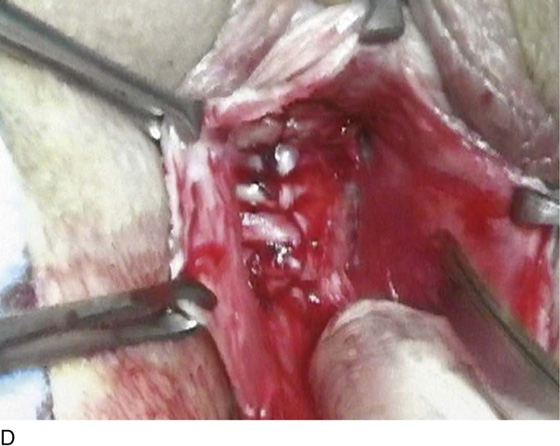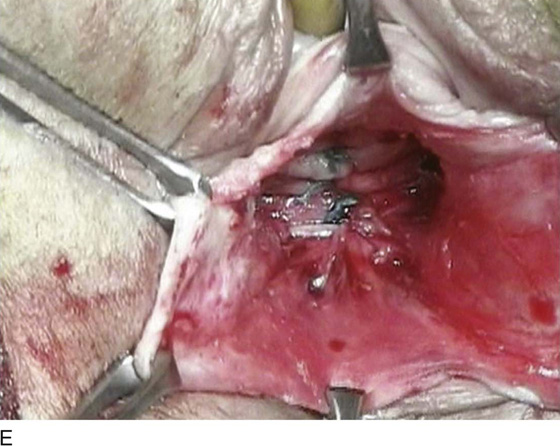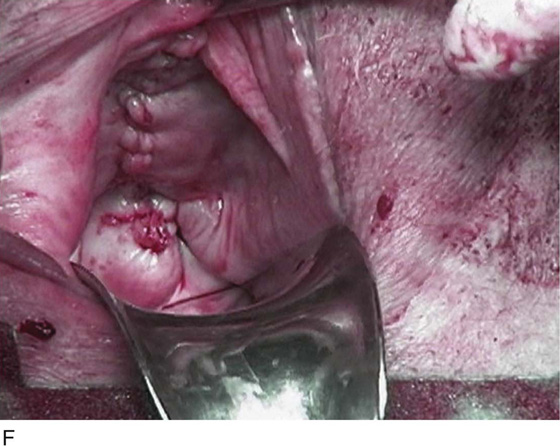CHAPTER 54 Anterior vaginal wall prolapse, or cystocele, is defined as pathologic descent of the anterior vaginal wall and overlying bladder base. The cause of anterior vaginal wall prolapse is not completely understood but is probably multifactorial, with different factors implicated in individual patients. Until recently, two types of anterior vaginal wall prolapse were described: distention and displacement cystocele. Distention cystocele was thought to result from overstretching and attenuation of the anterior vaginal wall, and displacement cystocele was attributed to pathologic detachment or elongation of the anterior lateral vaginal supports to the arcus tendineus fascia pelvis. More recently, three distinct defects have been described that can result in anterior vaginal wall prolapse. The midline defect is what has been previously described as a distention-type cystocele; the paravaginal defect, which is a separation of the normal attachment of the connective tissue of the vagina at the arcus tendineus fascia pelvis (white line); and the transverse defect, which occurs when the pubocervical fascia separates from its insertion around the cervix or at the apex (Figs. 54–1 through 54–5). Anterior vaginal wall prolapse, especially in the posthysterectomy patient, may be commonly associated with an apical enterocele, or more rarely a true anterior enterocele (Fig. 54–6). FIGURE 54–1 Two views of normal and abnormal support of the anterior vaginal wall. A. Lateral view of normal anterior vaginal wall support with bladder support extending back to the level of the ischial spines. Note normal midline and lateral support. B. Trapezoid concept of the support of the anterior vaginal wall. Note that the trapezoid extends back to the ischial spine on each side, and the fascia or the muscular lining of the vagina extends from one side of the pelvic sidewall to the opposite side with good midline support and lateral and transverse attachments. C. Lateral view of a midline defect. Note the bulging of the bladder into the midportion of the vagina with maintenance of lateral support. Thus, the anterior vaginal fornix is maintained on each side. D. Midline defect demonstrates weakening in the midportion of the trapezoidal support of the anterior segment. E. Lateral view of bilateral paravaginal defects. Note the complete detachment of the white line from its normal attachment, resulting in complete loss of the anterolateral supports of the anterior segment. F. Bilateral paravaginal defects. Complete lateral detachment of the normal support is noted as the trapezoid rotates outwardly. G. Lateral view of a transverse defect. Note that the bladder prolapse is between the normal upward attachment and the cervix or vaginal apex, usually resulting in what is termed a high cystocele. H. Note that the bladder descends around the normal upper attachment of the fascia or the muscular lining of the vagina. FIGURE 54–2 Normal support of the anterior vaginal wall when viewed retropubically. A.Note: The bladder has been removed. The bluish area depicts the inside lining of the fascia or the muscular lining of the vagina. In a normally supported anterior segment, this is a trapezoid-shaped support that extends from the arcus tendineus fascia pelvis on one side all the way to the opposite side, with the support extending all the way back to the level of the ischial spine laterally and to the apex or the cervix transversely. B. The bladder has been placed back into the illustration to show its normal anatomic position. C. Different possible types of defects, noting paravaginal, midline, and transverse defects. FIGURE 54–3 The anterior vaginal wall showing the urethrovaginal crease. Note that the vagina over the bladder base shows minimal rugae, a situation that is more consistent with a midline defect. FIGURE 54–4 The anterior vaginal wall with rugae, a situation that is more consistent with a paravaginal defect. FIGURE 54–5 Cross-sectional drawing of the pelvic floor to demonstrate (A) normal anatomy, (B) a midline defect of the anterior vaginal wall, and (C) a lateral or paravaginal defect of the anterior vaginal wall. FIGURE 54–6 Loss of anterior vaginal wall support. A cystocele that is coexistent with an apical or possibly an anterior enterocele in the posthysterectomy patient. Note that grossly the vaginal epithelium over an enterocele will appear to be much thinner than the vaginal epithelium over the prolapsed bladder. The objective of a midline anterior repair is to plicate the layers of the vaginal muscularis and adventitia overlying the bladder (pubocervical fascia). The operative procedure begins with the patient in the supine position and situated and prepped as for vaginal hysterectomy. A urethral Foley catheter is inserted for easy identification of the bladder neck. The anterior vaginal wall is then opened up via a midline incision (Fig. 54–7). If a vaginal hysterectomy has been performed, the incision is begun at the apex of the vagina by grasping this area with two Allis clamps (Fig. 54–8). Some prefer to inject a hemostatic solution before making any incisions. These various agents have been described in the chapter on vaginal hysterectomy. If there is only bladder base descensus and the bladder neck is well supported or has been previously supported via a retropubic suspension or sling procedure, then the incision need only extend to the level of the bladder neck. However, in most circumstances urethral hypermobility is present, and thus the anterior vaginal wall incision should extend to the level of the proximal urethra to allow for suburethral plication. FIGURE 54–7 Posthysterectomy cystocele showing the initial midline anterior vaginal wall incision. FIGURE 54–8 A. Injection (hydrodistention) of the anterior vaginal wall. Note that Allis clamps grasp the anterior vaginal wall at the vaginal apex after completion of vaginal hysterectomy. B. The scissors are separated, creating an appropriate plane for midline anterior vaginal wall dissection. After an initial incision is made, usually Mayo or Metzenbaum scissors are inserted between the vaginal epithelium and the vaginal muscularis or between the layers of the vaginal muscularis and are gently forced upward while they are partially opened and closed (Fig. 54–8B). The vagina is then incised, and the incision is continued to the desirable level, as was previously discussed. As the vagina is incised, the edges are usually grasped with Allis or T clamps and are drawn laterally for further mobilization. Dissection of the vaginal flap is then accomplished by turning the clamps back across the forefinger and incising the vaginal muscularis with scissors or a scalpel (Fig. 54–9). An assistant maintains constant traction medially on the bladder wall itself or on the remaining vaginal muscularis and underlying vesicovaginal adventitia. The dissection is extended bilaterally until the entire cystocele has been dissected off the vaginal wall (Figs. 54–10 to 54–13). Dissection should be continued until lateral assessment of vaginal support can be fully evaluated. This requires dissection to the inferior pubic ramus on each side. At this point the presence or absence of a paravaginal defect should be easily demonstrated (see Fig. 54–10). It is also important to sharply dissect the base of the bladder off the apex of the vagina in posthysterectomy cases (see Fig. 54–11). In most cases, regardless of whether the patient suffers from urinary incontinence, plicating sutures at the urethrovesical junction should be placed to augment the posterior urethral support in the hope of preventing de novo postoperative stress incontinence. To obtain durable tissue that can be plicated across the undersurface of the proximal urethra, it is important to extend the dissection all the way to the periurethral attachment at the level of the inferior pubic ramus (see Figs. 54–12 and 54–13). Usually a glistening white plane is present all the way to this area of attachment. Figures 54–14 and 54–15 demonstrate the technique of bladder neck plication in conjunction with midline cystocele repair. After stitches for the bladder neck plication have been placed and tied (see Fig. 54–14), attention is directed to the prolapsed bladder base. The goal of the midline cystocele repair is to reduce and provide support to the prolapsed bladder, as well as to provide preferential support to the bladder neck. The surgeon should try to avoid complete flattening of the posterior urethrovesical angle because this, in theory, may create incontinence (see Fig. 54–15). In the standard anterior colporrhaphy, 2-0 delayed absorbable sutures are placed in the muscularis and adventitia of the vaginal wall. Depending on the severity of the prolapse, one or two rows of plication sutures or a purse string suture followed by plication sutures is placed. The author prefers, if at all possible, to place two layers of sutures. For the initial layer, a 2-0 absorbable suture is used; this is followed by a second layer of 2-0 permanent suture (Figs. 54–16 and 54–17). The vaginal epithelium is then trimmed (Fig. 54–18), and the anterior vaginal wall is closed with a continuous 3-0 absorbable suture (Fig. 54–19). Figures 54–14 and 54–20 demonstrate, in succession, the steps of midline cystocele repair. FIGURE 54–9 A. Initial midline anterior vaginal wall incision. B. The incision is extended to the level of the proximal urethra. C. Sharp dissection and traction on the bladder facilitate dissection of the bladder off the vaginal wall. D. Mobilization of the cystocele off the vaginal wall is completed. FIGURE 54–10 Dissection has been extended to the normal lateral attachment of the pubocervical fascia to the sidewall. Note that no paravaginal defect is present. FIGURE 54–11 Dissection of the base of the bladder off the vaginal apex should be continued until the preperitoneal space is encountered. FIGURE 54–12 Lateral dissection of the cystocele off the vagina is complete. Note that the base of the bladder is still adherent to the apex of the vagina. FIGURE 54–13 A and B. Two examples of cystoceles that have been completely mobilized off the vaginal epithelium. FIGURE 54–14 Anterior colporrhaphy with Kelly plication in a patient with an isolated midline cystocele and bladder neck mobility. A. Midline anterior vaginal wall incision is made after hydrodissection. B. Appropriate plane of dissection is demonstrated. C. Dissection has occurred lateral to the level of the inferior pubic ramus; shown here is the sharp dissection of the base of bladder off the apex of the vagina. D. The first plication stitch is being placed at the level of the bladder neck. E. The first stitch has been tied, providing preferential support to the proximal urethra and bladder neck (Kelly plication). F. Subsequent stitches have been placed, completing the anterior colporrhaphy. G. Excess mucosa is trimmed. H. The anterior vaginal wall is closed. FIGURE 54–15 A. Kelly plication sutures have been placed and tied, plicating the pubocervical fascia across the midline at the level of the bladder neck. B. The bladder base has been plicated. Inset. Preferential support of the bladder neck compared with the bladder base. C. The bladder neck and the bladder base both have been plicated at the same level. Inset. Complete loss of the posterior urethrovesical angle. This should be avoided as it may lead to the development of de novo stress incontinence. FIGURE 54–16 Bladder base plication sutures have been placed and tied. FIGURE 54–17 A. The initial layer of sutures has been placed, plicating the cystocele. B. The second layer of plication sutures completes the cystocele repair. FIGURE 54–18 Excess anterior vaginal wall epithelium is excised. FIGURE 54–19 The anterior vaginal wall is closed with continuous or interrupted 3-0 absorbable sutures. FIGURE 54–20 The technique of midline cystocele repair with Kelly plication. A. The anterior vaginal wall in this posthysterectomy patient is grasped with two Allis clamps, and a vasoconstrictive agent is injected to facilitate dissection in the appropriate plane. B. The anterior vaginal wall has been opened up, and dissection has been extended laterally on each side. Also, note that dissection must involve mobilizing the base of the bladder off the apex of the vagina. C. Dissection is extended to the inferior pubic ramus on each side. Note the good paravaginal attachment, ruling out any paravaginal defect in this patient. D. The midline cystocele has been initially plicated with delayed absorbable suture. Note: Plication sutures have been placed at the proximal urethral bladder neck to provide preferential support over those placed over the base of the bladder. E. Dissection has been extended farther laterally to facilitate the development of more fascia, and a second layer of permanent sutures is now used to complete the midline cystocele plication. F. After the anterior vaginal wall is trimmed, the anterior vaginal wall is closed with a 3-0 delayed absorbable suture. Note the excellent support of the anterior segment in the midline with maintenance of good lateral vaginal sulci on each side. Some surgeons prefer to augment anterior vaginal wall repair with a free graft of tissue or mesh, which can be biologic or synthetic. The mesh or tissue is placed over the stitches and is anchored in place at the lateral limit of the previous dissection or at the inside of the anterior vaginal wall (Figs. 54–21 and 54–22). If bilateral paravaginal defects are present, the material can be attached to the arcus tendineus fascia pelvis on each side (Fig. 54–23). Materials that have been utilized have included rectus abdominis, fascia lata, and cadaveric fascia lata, as well as synthetic mesh such as Marlex, Mersilene, or Prolene. Indications for mesh-augmented prolapse repairs remain very controversial. Some surgeons believe that repairs should be augmented in recurrent cases and in women with a very poor or little muscular component to their vaginal skin, which is usually secondary to long-standing urogenital atrophy (Fig. 54–24). At times a cystocele coexists with an enterocele (Fig. 54–25A). In this situation it is important to dissect out the individual defects, thus completely mobilizing the enterocele sac from the cystocele. Each defect is then individually repaired, and, if indicated, the vaginal vault is suspended (see Fig. 54–25).
Vaginal Repair of Cystocele, Rectocele, and Enterocele
Anterior Vaginal Wall Prolapse
Midline Cystocele Repair
Vaginal Paravaginal Repair
Stay updated, free articles. Join our Telegram channel

Full access? Get Clinical Tree


